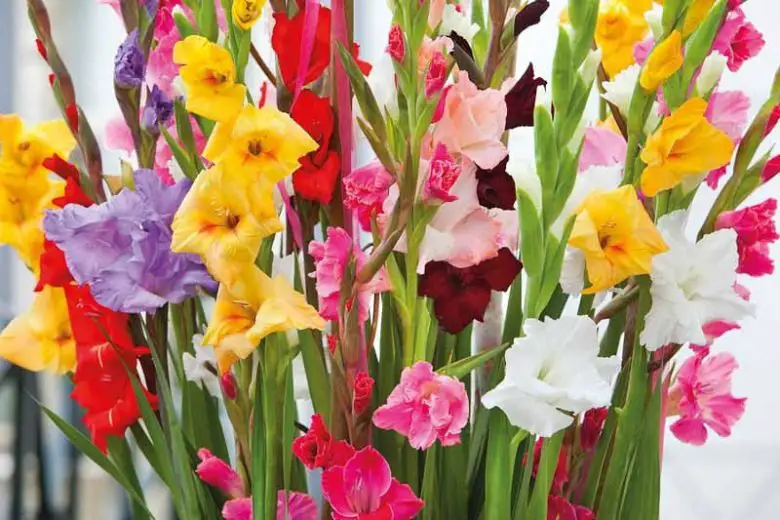Gladiolus, often called “sword lilies,” are among the most striking flowers in any summer garden. Their tall, elegant spikes rise proudly above the foliage, creating waves of color that draw every eye. Each stalk bursts into vibrant blooms that last for weeks, making gladiolus a favorite for both gardeners and floral designers. But to keep these flowers blooming beautifully, they need consistent, attentive care throughout the growing season. Every stage—from planting to post-bloom maintenance—affects their strength and flower quality.
Learning how to care for gladiolus properly can make the difference between short-lived spikes and continuous, vibrant blooms. These plants require the right balance of sunlight, soil, water, and nutrients to thrive. With proper care, gladiolus can reward you with tall, healthy stems and vivid flowers that brighten your garden from early summer to fall. This guide will cover every essential step to help your gladiolus bloom longer and more brilliantly each year.
Understanding Gladiolus Growth and Bloom Cycle

Understanding the growth cycle of gladiolus is the key to caring for them successfully. Each plant begins life from a corm, which stores the nutrients needed for early growth. Once planted, the corm produces long, sword-like leaves that gather energy from sunlight. This process strengthens the bulb and prepares it for flowering. Within eight to twelve weeks, depending on temperature and variety, the gladiolus begins to send up a tall flower spike. Blooms then open from the bottom upward, allowing the plant to display color for several weeks and providing gardeners with continuous beauty through summer.
Gladiolus are seasonal growers that depend heavily on warm soil and consistent moisture. Their active growth starts in late spring and continues until the first frost. During this time, the plant uses sunlight and nutrients to create new energy reserves inside the corm. Healthy foliage is a clear sign of proper growth, while weak or yellowing leaves often indicate poor soil or lack of nutrients. Once the blooming phase begins, flowers open sequentially, each lasting several days before fading. Cutting the flowers for arrangements does not harm the plant if you leave enough foliage to photosynthesize afterward.
After blooming, the plant enters a critical recovery period. The leaves should remain intact until they turn completely yellow and dry out. This signals that the corm has finished gathering energy and is ready for dormancy. During this resting stage, the bulb restores its strength for the next growing season. Understanding these phases allows gardeners to adjust watering, feeding, and lifting times precisely. When managed correctly, each cycle produces stronger corms, taller spikes, and brighter, longer-lasting blooms year after year.
Choosing the Right Location and Soil for Gladiolus
Choosing the right growing location is one of the most important steps in caring for gladiolus. These sun-loving plants need at least six to eight hours of direct sunlight each day to produce tall spikes and vibrant blooms. Without enough light, the stems become weak and flowers may fail to open fully. A sunny, open space with good air circulation helps prevent fungal issues and promotes stronger growth. Avoid planting them near large trees or tall shrubs that create shade or compete for nutrients. A location that receives gentle morning sunlight and some afternoon protection from intense heat works best for consistent, healthy flowering.
Soil quality also plays a vital role in the success of gladiolus. They thrive in loose, well-drained soil that is rich in organic matter. Heavy clay or compacted soil causes water to collect around the bulbs, leading to rot. Before planting, loosen the soil at least ten inches deep and mix in compost, aged manure, or peat moss to improve drainage and fertility. The ideal soil pH is slightly acidic to neutral, between 6.0 and 7.0. This balance ensures the bulbs can absorb essential nutrients efficiently throughout the growing season.
Good soil preparation helps gladiolus establish strong root systems quickly. Adding a small amount of balanced fertilizer before planting gives them an early boost. Raised beds are an excellent option in areas with poor drainage, as they allow excess water to flow away easily. Once planted, maintaining evenly moist but not soggy soil encourages steady, healthy growth. With the right combination of sunlight and soil structure, gladiolus will reward you with brilliant blooms and sturdy stems all summer long.
Planting Gladiolus Bulbs the Right Way
Proper planting is the foundation for strong, healthy gladiolus plants. The best time to plant bulbs, or corms, is in spring after the danger of frost has passed and soil temperatures stay above 55°F (13°C). Choose plump, firm corms free from mold or soft spots. Planting depth is crucial for stability and growth—bury bulbs about four to six inches deep, depending on size. Spacing each corm six inches apart allows enough room for air circulation and prevents overcrowding. Position the pointed end upward to help the shoots emerge easily. Press the soil gently over the bulbs and water thoroughly to settle them in place.
To achieve continuous blooms all season, stagger your planting schedule. Plant a new group of bulbs every two weeks until early summer. This simple technique ensures a rolling display of color from midsummer to early autumn. Gladiolus prefer warm soil and consistent moisture but dislike soggy conditions. Water deeply after planting and keep the soil evenly moist during early growth. Applying a light layer of mulch helps retain moisture and suppress weeds. It also keeps the soil temperature stable, promoting steady root development.
For gardeners in colder regions, planting in raised beds or containers offers better drainage and frost protection. Mixing sand or fine gravel into the soil improves aeration and prevents rot. Once shoots appear, remove weeds gently to avoid disturbing young roots. Providing early care and proper spacing ensures tall, sturdy spikes capable of supporting multiple blooms. When planted correctly, gladiolus bulbs grow quickly and deliver long-lasting, colorful displays that brighten gardens and landscapes throughout summer.
Watering and Fertilizing Gladiolus for Healthy Growth
Watering Gladiolus the Right Way
Proper watering is one of the most important parts of gladiolus care. These plants need consistent moisture but should never sit in soggy soil. Gladiolus roots grow deep, so watering thoroughly once or twice a week is better than frequent shallow watering. Deep watering encourages strong root systems that support tall flower spikes. During hot or dry periods, check the soil regularly. If the top two inches feel dry, it’s time to water again. Avoid overhead watering, as wet foliage can lead to fungal diseases like leaf spot or blight. Instead, water at the base of the plant to keep the leaves dry and healthy.
Mulching helps maintain consistent soil moisture and reduces the need for frequent watering. A two-inch layer of straw, compost, or bark mulch also prevents weeds from competing for water and nutrients. However, do not pile mulch directly against the stems—it can trap moisture and cause rot. In heavy rainfall areas, ensure proper drainage so bulbs do not stay waterlogged. Balanced watering practices keep gladiolus foliage lush and green while encouraging steady flower development. Consistent hydration at every growth stage ensures healthy plants and vibrant blooms that last throughout the summer.
Fertilizing Gladiolus for Stronger Blooms
Fertilization provides gladiolus plants with the nutrients they need to grow tall and produce vivid flowers. Before planting, work a balanced fertilizer such as 10-10-10 into the soil to give bulbs an early boost. Once shoots appear, apply a light dose of the same formula every two to three weeks during active growth. Nitrogen promotes healthy foliage, while phosphorus and potassium strengthen roots and improve bloom size. Overfertilizing, especially with too much nitrogen, can lead to weak stems and fewer flowers, so moderation is key. Always water after fertilizing to help nutrients reach the root zone and prevent fertilizer burn.
Organic gardeners can use compost tea, seaweed extract, or fish emulsion as natural alternatives. These options enhance soil structure and provide slow-release nutrients that keep gladiolus growing steadily. Stop fertilizing when flowers begin to open; at that stage, the bulbs start storing energy for next year’s growth. Feeding them after bloom can weaken the corm. Consistent fertilization throughout the early and mid-season ensures your gladiolus plants grow strong, produce tall spikes, and deliver radiant, long-lasting blooms year after year.
Supporting and Protecting Gladiolus Stems
How to Support Gladiolus Stems
Because gladiolus spikes can grow up to five feet tall, they often need firm support to prevent bending or breakage. Staking early is the key to keeping them upright and healthy. Begin when the plants reach about ten inches tall, before the spikes appear. Insert slender bamboo stakes or thin metal rods about two inches from each plant, avoiding damage to the bulb. Use soft twine, garden tape, or cloth strips to tie the stems loosely. The goal is to stabilize without restricting natural movement or cutting into the stem. A well-tied plant can sway with the wind while remaining fully supported.
For larger beds, use wire mesh or netting stretched horizontally a foot above the soil. The shoots will grow through the grid and gain support naturally. This technique prevents toppling and helps flowers develop straight, elegant spikes. Group planting also improves stability by reducing wind exposure. Recheck ties every week to loosen them as stems thicken. Early staking prevents root disturbance and ensures uniform growth. By maintaining proper support, your gladiolus plants will stay upright, showcase their height beautifully, and produce flawless spikes ready for garden displays or cutting arrangements.
Protecting Gladiolus from Harsh Weather
Gladiolus plants are sensitive to extreme weather, so protection is vital for long-term health. Strong winds, heavy rain, or hail can easily break stems or damage flowers. Choose a sheltered planting location near fences or hedges to buffer against wind. In open gardens, temporary windbreaks made of garden mesh or wooden panels provide effective shielding without blocking sunlight. Spacing plants properly also helps improve airflow, allowing moisture to evaporate quickly and reducing fungal risk after rain.
During very hot weather, the petals can scorch or lose color intensity. Apply a two-inch mulch layer around the base to stabilize soil temperature and conserve moisture. If temperatures exceed 90°F (32°C), a light shade cloth in the afternoon helps prevent stress. After storms, inspect your plants immediately, re-stake leaning stems, and trim damaged flowers to redirect energy to healthy growth. Applying a mild fungicide after prolonged rain can also prevent mold and rot. With careful protection and quick recovery measures, gladiolus plants remain strong, resilient, and capable of blooming beautifully despite unpredictable weather.
Deadheading and Post-Bloom Care for Gladiolus
Once gladiolus flowers begin to fade, proper post-bloom care ensures the plant remains strong and ready to bloom again next season. Deadheading—the removal of spent blooms—helps redirect the plant’s energy from seed production back into the corm. To deadhead, use clean garden shears to cut off the fading flower stalks just above the first set of leaves. Always leave the foliage intact, as it continues to photosynthesize and store nutrients in the bulb below. Removing dead blooms regularly also prevents the garden from looking untidy and reduces the risk of fungal infections developing on decaying petals.
After blooming ends completely, gladiolus enters a recovery stage. During this time, continue watering moderately so the leaves can replenish the bulb with stored energy. Avoid overwatering, which can cause root rot in late summer. Apply a light dose of potassium-rich fertilizer to strengthen the corm and prepare it for dormancy. Once the foliage turns completely yellow and begins to wither, stop watering. At this stage, the corm is mature and ready for lifting or overwintering, depending on your local climate. This post-bloom phase is essential for building next year’s flower quality.
Gardeners in colder regions should dig up the bulbs about six weeks after flowering. Gently remove soil, trim the stems to a few inches, and allow the bulbs to dry in a shaded area for about two weeks. After curing, store them in a cool, dry place until spring. In warmer climates, bulbs can remain in the ground if the soil drains well and frost is rare. Consistent post-bloom care preserves bulb health, ensuring that each new season begins with vigorous growth and dazzling spikes of color.
Seasonal Care for Gladiolus
Spring Care for Gladiolus
Spring is when gladiolus begins its life cycle and builds the strength it needs for summer blooms. As soon as frost danger passes and soil temperatures stay above 55°F (13°C), it’s time to plant. Loosen the soil deeply, about ten inches, and enrich it with compost or organic matter. Select a sunny location that receives at least six to eight hours of light daily. To enjoy blooms all season, plant new corms every two weeks until late spring. This staggered planting method ensures continuous color throughout summer.
After planting, water the soil deeply and keep it evenly moist without overwatering. Applying a layer of mulch helps retain warmth, conserve water, and suppress weeds. If you start bulbs indoors, gradually acclimate them to outdoor temperatures before transplanting. A balanced fertilizer with equal parts nitrogen, phosphorus, and potassium encourages root and leaf growth. Checking soil drainage early prevents rot later in the season. Spring care is about giving gladiolus a strong foundation—healthy roots, rich soil, and consistent moisture will guarantee tall spikes and colorful flowers when summer arrives.
Summer Care for Gladiolus
Summer is the most active phase for gladiolus, when strong care ensures long-lasting blooms. During hot months, consistent watering is essential. Deeply water once or twice weekly so moisture reaches the roots rather than staying near the surface. Avoid overhead watering, which can cause leaf diseases; instead, water gently at the base. Add mulch to keep soil cool, prevent weeds, and retain moisture during heat waves. Regular weeding also helps roots breathe and absorb nutrients efficiently.
Fertilize every two to three weeks with a phosphorus-rich formula to promote flower size and color. Remove fading flowers promptly to extend the blooming period and maintain garden beauty. If stems grow tall or heavy, secure them with stakes before winds or rain cause bending. Inspect plants weekly for thrips or aphids and treat early using neem oil or mild soap spray. Summer is also the best time to cut gladiolus for floral arrangements—cut early in the morning when lower flowers begin to open. Proper summer care keeps gladiolus healthy, vibrant, and in bloom until the first signs of fall.
Fall Care for Gladiolus
Fall is the season for rest and renewal, helping gladiolus prepare for dormancy. Once flowering stops, allow the leaves to stay until they turn yellow and wither naturally. The foliage collects sunlight and sends nutrients to the corm, strengthening it for the next growing cycle. Continue watering lightly but reduce frequency as temperatures cool. Cutting foliage too soon deprives the bulb of stored energy and leads to smaller blooms next year.
When the leaves are fully dry, gently dig up the bulbs with a garden fork. Shake off soil carefully, avoiding damage. Cut the stems back to one inch and let the bulbs cure in a dry, airy place for two weeks. After curing, remove old, shriveled corms attached beneath the new ones. Label each variety before storing them in mesh bags or boxes with dry peat moss. If you plan to divide cormels, do so now and save them for spring propagation. Fall care is crucial for maintaining bulb vitality, ensuring your gladiolus remains strong through winter and ready for another spectacular blooming season.
Winter Care for Gladiolus
Winter marks the resting stage of gladiolus, but this period is vital for preserving the bulbs’ health. In regions with freezing winters, dig up and store bulbs indoors once the soil cools. Keep them in a cool, dark, and dry space with temperatures between 35°F and 50°F (1°C–10°C). Use mesh bags, paper sacks, or boxes filled with dry peat moss or vermiculite to prevent moisture buildup. Check monthly for rot, mold, or shriveling, and remove any affected bulbs immediately. Replace damp packing material to maintain dryness.
In warm regions where frost rarely occurs, bulbs can remain in the ground. However, apply a thick four-inch mulch layer to protect against cold snaps and preserve soil moisture. Avoid heavy watering, which causes rot during dormancy. If growing gladiolus in pots, move containers to sheltered spots safe from wind and rain. Winter may seem inactive, but this rest allows corms to recharge. Proper protection during this time ensures your gladiolus reawakens in spring with strong shoots, healthy roots, and vibrant colors ready to brighten your garden again.
Common Problems and How to Fix Them
Pest Damage on Gladiolus
Pests are one of the most common causes of weak gladiolus growth and poor blooming. Thrips, small sap-sucking insects, are the biggest threat. They feed on leaves and flower buds, leaving silvery streaks and distorted petals. Aphids and spider mites also attack the plants, draining nutrients and causing yellowed foliage. These pests thrive in hot, dry conditions and often go unnoticed until damage appears. To prevent infestations, check your plants weekly, especially on the undersides of leaves and developing buds. Early detection makes control much easier and prevents spreading to nearby plants.
Treat affected plants with neem oil or insecticidal soap, which kills pests safely without harming beneficial insects. Repeat applications every few days until the problem disappears. In severe infestations, removing heavily damaged flower spikes can protect healthy ones. Keeping the area around your gladiolus clean and free of debris also discourages pests from hiding or overwintering in the soil. Healthy, well-watered plants are less likely to attract insects, so maintaining proper care is the best prevention. Regular monitoring and prompt treatment keep gladiolus vibrant, pest-free, and ready to bloom beautifully each season.
Fungal and Bacterial Diseases
Fungal and bacterial infections are another frequent issue for gladiolus, especially in warm, humid conditions. The most common fungal diseases include botrytis blight, fusarium wilt, and corm rot. Symptoms often appear as yellowing leaves, brown spots, or soft, discolored bulbs. Poor drainage, overwatering, and crowded plantings create ideal environments for these pathogens. To prevent disease, always plant gladiolus in well-draining soil and avoid wetting the foliage when watering. Proper spacing ensures air circulation, helping leaves dry faster after rain or irrigation.
If infection occurs, remove and destroy infected leaves or bulbs immediately. Applying a fungicide containing copper or sulfur can help control mild outbreaks. Before storage, treat bulbs with an antifungal dust or soak them in a mild fungicidal solution for ten minutes. Allow them to dry completely before storing. Rotating planting locations every few years prevents disease buildup in the soil. Clean tools and containers regularly to avoid cross-contamination. Healthy soil, good hygiene, and careful watering form the foundation of disease prevention, keeping your gladiolus strong and resistant to future infections.
Environmental Stress and Growth Issues
Environmental stress can significantly impact gladiolus growth and flowering quality. Extreme temperatures, poor soil, or inconsistent watering often lead to weak stems, small blooms, or yellowing leaves. Prolonged drought reduces flower size, while sudden heavy rain may cause root rot. Gladiolus prefer stable conditions—warm days, cool nights, and evenly moist soil. In hot climates, provide partial afternoon shade to protect flowers from heat damage. In cooler areas, plant in full sun to encourage strong growth. Consistent watering is key to maintaining balance.
Nutrient deficiencies can also cause growth problems. Too much nitrogen leads to lush leaves but fewer flowers, while low phosphorus weakens roots. Using a balanced fertilizer and maintaining soil pH between 6.0 and 7.0 helps prevent these issues. Staking tall varieties reduces mechanical stress caused by wind or rain. Regular mulching protects roots from temperature fluctuations. By managing environmental conditions carefully, gardeners can prevent stress-related problems and help gladiolus perform at their best—producing tall spikes and brilliant, long-lasting blooms season after season.
Tips for Long-Lasting Gladiolus Blooms
Keeping gladiolus flowers blooming longer requires attention to timing, watering, and maintenance. One of the simplest techniques is staggered planting. By planting new corms every two weeks during spring, you can enjoy a steady wave of blooms from early summer until fall. Regular deadheading also helps extend the bloom period by preventing the plant from wasting energy on seed production. Cut fading flowers just above the first set of leaves to redirect nutrients to developing buds. In hot climates, provide partial afternoon shade to protect petals from heat stress and fading colors. Consistent watering is also crucial, especially during the peak blooming period.
Balanced feeding contributes greatly to bloom longevity. Use a fertilizer with slightly higher potassium levels once buds start forming, as potassium strengthens stems and enhances flower color. Avoid excess nitrogen during this phase because it encourages leafy growth rather than blooming. Maintain soil moisture evenly and avoid letting it dry out completely between watering sessions. A thin layer of organic mulch keeps the soil cool and reduces evaporation, creating stable conditions for the bulbs. These habits help the plants maintain energy throughout their flowering stage, resulting in larger and longer-lasting blooms.
Cutting flowers for indoor arrangements also requires timing and technique. Harvest gladiolus early in the morning when the lower flowers are just beginning to open. Use clean, sharp shears and cut diagonally across the stem to improve water absorption. Remove a few lower leaves but keep several at the base to continue feeding the corm. Immediately place the stems in lukewarm water to prevent air bubbles from blocking uptake. With these simple but effective steps, you can enjoy radiant gladiolus blooms both in your garden and inside your home for weeks at a time.
FAQs about Gladiolus Care
How often should I water gladiolus?
Gladiolus prefers consistently moist soil but not soggy conditions. Water deeply once or twice a week so moisture reaches the roots. During hot or windy weather, check the top two inches of soil and water again if dry. Proper watering prevents wilted leaves, promotes sturdy stems, and extends bloom duration.
Do gladiolus need full sun to bloom?
Yes, gladiolus needs full sun for at least six hours daily to bloom well. Sunlight helps produce strong stems and vibrant colors. Without enough light, flowers become dull and stems weak. In hot climates, give them partial afternoon shade to prevent scorching and maintain bright, long-lasting blossoms.
When should I plant gladiolus bulbs?
Plant gladiolus bulbs in spring, two weeks after the last frost, when soil temperatures reach 55°F (13°C) or higher. For continuous blooms, plant new bulbs every two weeks until early summer. This staggered method ensures waves of colorful flowers throughout the warm growing season, from June to September.
Can gladiolus grow in pots?
Yes, gladiolus grows beautifully in large, deep containers with excellent drainage. Use rich, well-draining soil mixed with compost and water regularly to keep it evenly moist. Choose dwarf or medium-height varieties for pots, and provide support stakes for taller types to keep spikes upright during blooming.
How do I make gladiolus blooms last longer?
To extend gladiolus bloom life, deadhead fading flowers promptly and keep soil evenly moist. Use fertilizer rich in potassium once buds appear. Avoid excessive nitrogen, which delays blooming. In hot weather, provide light shade and cut flowers early in the morning, placing them in cool water immediately.
Conclusion
Caring for gladiolus is simple once you understand their needs. With proper sunlight, well-drained soil, balanced watering, and timely feeding, these elegant flowers will reward you with breathtaking color and height all summer long. Regular maintenance, protection from pests, and careful post-bloom care strengthen bulbs for the next season. When nurtured thoughtfully, gladiolus will return each year with taller spikes, richer hues, and endless beauty—turning every corner of your garden into a vibrant showcase of summer grace.






